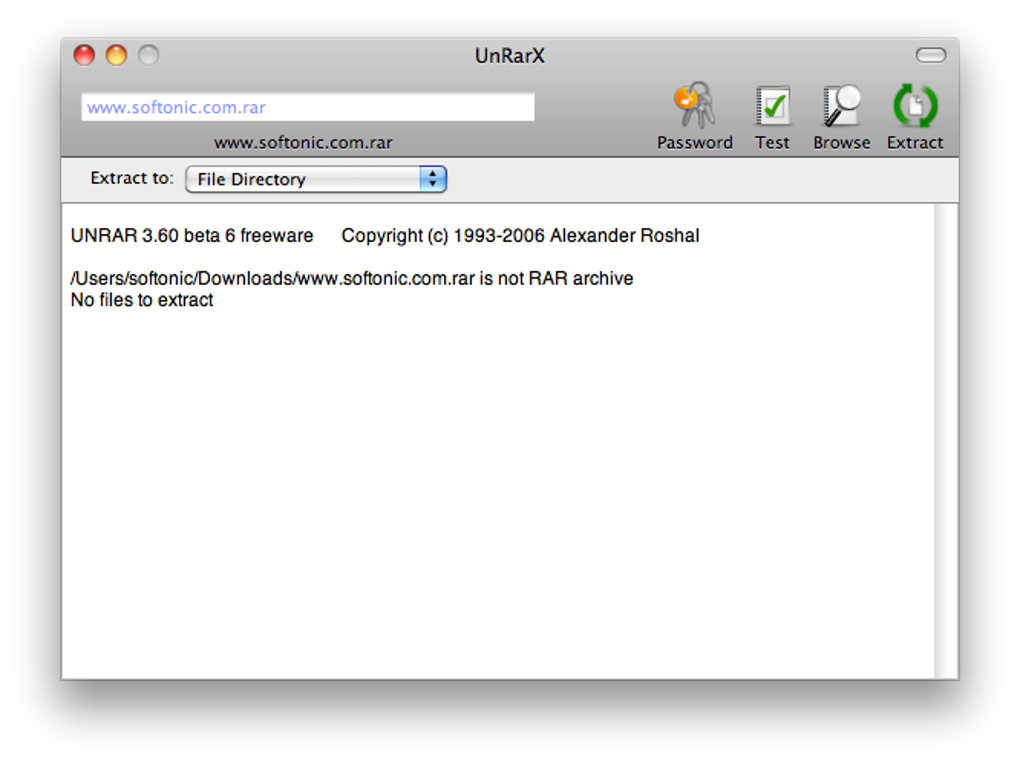Latest Version:
unRarX 2.2 LATEST
Requirements:
Mac OS X
Author / Product:
Peter Noriega / unRarX for Mac
Old Versions:
Filename:
UnRarX.zip
MD5 Checksum:
9f3da561a7cf3ac5de67ad1efcf9a8e6
Details:
unRarX for Mac 2020 full offline installer setup for Mac
I've installed UnRarX, now how do I extract files from the RAR Archive?
The easiest way to begin extracting your RAR archive is to launch the UnRarX Mac app and drag your RAR archive into the main window.
Extraction fails with CRC Error
One or more of your RAR archives may be damaged. If you have a par2 file that accompanies your RAR files, simply drag your par2 file into the app window to begin the recovery process.
UnRarX can't extract RAR archive or cannot write to File Directory?
In some cases, depending on the permission's settings on your computer Un RarX is unable to extract files from the RAR archive. My advice in this situation is to try extracting the files to your 'Desktop' instead of the 'File Directory'.
If you have more than one Mac you want to upgrade to macOS 10.15 Catalina but don't want to waste so much bandwidth downloading it for each machine, one option is to create a bootable installer on a spare USB flash drive. Here's how to do it with the Terminal.

If WinRar source code was open, I would try to port it to Mac OS. It is the best unarchiver ever created. There is command line only version, though, but most people would prefer GUI. UnRarX is an application for Mac developed by Cocoa that gives us the possibility to decompress RAR files using the interface of the program and not having to use command files. You'll only have to double-click a RAR file in Finder and it will be unpacked. Those who have migrated from Windows to Mac often feel the need of a good utility tool that would help them in unzipping the files like WinRAR. The RAR files often become a problem for Mac users. However, if they use the UnRarX, they can simply drag and drop function.
One of the problems with the release of a major operating system update like macOS Catalina is the amount of times it has to be downloaded. As Apple usually intends each Mac or MacBook needing to be updated to download it, the process isn't really efficient enough for instances where many Mac desktops need the upgrade, like in a school or business if there isn't device management or macOS Content Caching for whatever the reason.
The strain could also be felt by users who own multiple Macs but also have a limited data allowance from their Internet provider, or a small amount of bandwidth that could make updating multiple machines take a very long time and saturate the available connection.
While in the olden days it was possible to get the software update on physical media, Apple doesn't offer that option anymore. However, it is still possible to create your own media, such as a spare USB thumb drive, that can do the same job.
The first hurdle is to actually get the macOS Catalina installer onto a Mac. This is an unavoidable part of the process and will require just over 8 gigabytes of drive capacity to store.
Go to the Mac App Store and search for Catalina using the search bar, then click on View next to the macOS Catalina listing. Alternately, open the Mac App Store Preview page for macOS Catalina here then select View in Mac App Store.
Click on Get. This will load up the Software Update utility, which will ask if you want to download macOS Catalina. Click Download.
After the download has finished, macOS will automatically start the installer. Press Command-Q to quit the installer before it continues, as the update will be deleted upon installation.
Creating the Bootable Drive
You need an external drive to turn into a bootable version, and since it needs to be portable, your best choice is a USB thumb drive with a capacity of 16GB or more. Be aware that the drive will be wiped as part of the process, so ensure there isn't any precious data on the drive that could be lost if it isn't backed up elsewhere.
Connect the external drive to your Mac, and make a note of the external drive's name as it appears within macOS. This is important, as using the wrong name could lead to another connected drive being wiped by mistake.
Open Terminal within the Utilities folder within the Applications folder and enter in the following command by copying and pasting it directly into the window. Make sure to change the element titled 'USBdrive' for the name of the drive you intend to become the bootable installer.
sudo /Applications/Install macOS Catalina.app/Contents/Resources/createinstallmedia — volume /Volumes/USBdrive — /Applications/Install macOS Catalina.app

Once pasted and corrected, press enter, then enter your password for macOS and press enter again.
Terminal will then warn of the USB drive being wiped as part of the process. Type 'Y' and press enter. Leave the Mac alone as it formats and copies over the installer.
Once Terminal says 'Install media now available,' it is safe to right-click the removable drive on the desktop renamed 'Install macOS Catalina' and select the 'Eject' command. It is now safe to remove the drive from the Mac.
Upgrading another Mac
Before proceeding, ensure there are adequate backups available for the Mac you are about to upgrade before the process starts.
With the target Mac you want to upgrade turned off, connect your external drive. When turning on the Mac, hold down the Option key on the connected keyboard to bring up the Startup Manager.
Unrarx For Mac Os Catalina 2017
The Startup Manager is used to boot from a different drive from the default. In this case, select 'Install macOS Catalina.'
The Mac will then bring up a macOS Utilities window. To perform a straight update, select 'Install macOS' and follow the prompts.
The macOS Utilities menu also allows you to erase the Mac's drive, which you can optionally do if you do not wish to save any of the data and want a completely clean slate for the installation.
Unrarx For Mac Os Catalina Download
AppleInsider has affiliate partnerships and may earn commission on products purchased through affiliate links. These partnerships do not influence our editorial content.